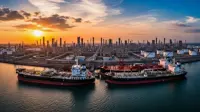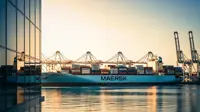Cochin Shipyard Limited (CSL) is constructing New Dry Dock, one of the largest such facility in India, at an estimated cost of Rs1,799 crore. This dry-dock will have a length of 310 metres and will be a stepped dock with a width of 75 metres at the wider part and 60 metres at the narrower part. It will have a depth of 13 metres and a drought of 9.5 metres.
The new dry-dock, when commissioned, will help CSL to have a more diversified product profile. This, dual purpose dry dock is planned essentially to tap the market potential of repairs/ construction of specialised and technologically advanced large vessels such as LNG vessels, Jack Up Rigs. Drill Ships, large dredgers, aircraft carriers and repair of offshore platforms and larger vessels.
The new dry dock will be able to comfortably handle aircraft carriers of 70,000 tonnes docking displacement and tankers and merchant vessels of 55,000 tonnes docking displacement. The dock floor is designed to take a loading of 600 tonnes/metre. The design caters for sufficient safety margins as per international codes. The new dock is expected to be commissioned by July 2023.
Cochin Shipyard Limited had taken over on 30 years lease the existing ship repair facility of Cochin Port Trust (CoPT) located at Willingdon Island, Kochi and is in the process of developing it into a state-of the-art International Ship Repair Facility (ISRF) by installing ship lift and transfer system, six dry berths and associated facilities at an estimated cost of Rs970 crore. The ISRF will modernise, expand and substantially augment the existing ship repair capacity of CSL. The ISRF includes 6,000 tonne shiplift for ships up to 130 x 25 m with six work stations and allied facilities, and total outfitting berth of 1,500 meters approx. The facility is expected to be commissioned by January 2023.
Besides, CSL had set up Hooghly Cochin Shipyard Limited (HCSL), as a joint venture with Hooghly Dock & Port Engineers Limited (HDPEL), aimed at supporting inland water vessel construction in line with the government’s vision of developing the country’s national waterways. Pursuant to the union cabinet approval, HCSL has become a wholly owned subsidiary of CSL with effect from 1 November 2019. Initially set up at Kolkata, HCSL targets to develop various types of vessels like Ro-Ro vessels, river-sea cargo vessels for bulk, liquids, containers, passenger vessels and other watercrafts for the inland waterways. The total investment for this project is Rs168 crore. The facility is currently ready for operations.
As part of its long term strategy, viz, `CRUISE 2030’, CSL aspires to achieve 6 to 8 fold growth by 2030 and towards this the company has identified deep sea fishing vessel construction as one of the potential opportunities. Since fishing vessel segment calls for a dedicated facility so as to cater to the large volume of business which is different from the conventional shipbuilding process, CSL was in search of a suitable facility to enter into this segment. CSL found an opportunity in TSL, Malpe, which was under the corporate insolvency resolution process (CIRP) under the Insolvency and Bankruptcy Code, 2016 (IBC) and bidding for TSL through IBC was considered appropriate. Accordingly CSL submitted its resolution plan, which was approved by the National Company Law Tribunal (NCLT), Chennai on 4 March 2020. The facility is now a 100 per cent owned subsidiary of CSL. An amount of Rs70 crore has been invested and the facility is currently operational.
CSL commenced operations of its Mumbai Ship Repair Unit in October 2018 through an agreement with the Mumbai Port Trust to upgrade, operate and manage Ship Repair Facility at Hughes dry-dock and berth nos. 5, 6, 7 and 8 of Indira Dock of Mumbai Port. Subsequent to the execution of the agreement, CSL has commenced ship repair operations in Mumbai. The facility undertakes repairs of both defence and commercial ships.
CSL commenced operations of its Kolkata Ship Repair Unit in March 2019 through an agreement with Kolkata Port Trust for operations and management of ship repair facility at Netaji Subhas Dock (NSD) for a period of 30 years. The new venture is being managed by a separate unit of CSL known as CSL-Kolkata Ship Repair Unit (CKSRU). Prime Minister Narendra Modi formally inaugurated the CKSRU facility on 12 January 2020. The facility undertakes repair of both defence and commercial ships.
CSL commenced operations of its Andaman unit at Port Blair through an agreement with the Andaman & Nicobar (A&N) Administration for ship repair at the Marine Dockyard, a facility that is currently being operated directly by the A&N Administration. Under the ambit of this agreement, CANSRU will assist the administration in developing an overall ship repair ecosystem at Andaman & Nicobar Islands. CANSRU will also assist and associate in augmentation and modernisation of existing facilities. Focus is on skill development in consultation with the administration and technical institutions located in the Islands, is also part of the mandate of the agreement. The agreement is for a period of 30 years, during which CSL is expected to spruce up the operational efficiency of the dockyard as well as improve the overall ship repair ecosystem in the island to ensure faster turnaround and minimise downtime of the vessels, which are the lifeline for the islands.
The government, on its part, has taken various measures for strengthening the shipping sector and make it internationally competitive.
Accordingly, it has revised the criteria for granting the Right of First Refusal (ROFR) in chartering of vessels through tender process, for promoting tonnage under Indian flag and ship-building in India, so as to make India an `Atma-nirbhar’ Bharat, in terms of tonnage and ship-building in India.
The following is the revised hierarchy of RoFR:
- Indian built, Indian flagged (Indian owned);
- Foreign built, Indian flagged (Indian owned);
- Indian built, foreign flagged (foreign owned).
This will promote demand of Indian built vessels as the Indian built vessels will have the priority in chartering and will also provide additional market access and business support to ships built in India. Further, financial assistance is provided to Indian shipyards in order to promote Indian industry and to enable them to acquire global shipbuilding contracts while competing in international markets.
The revised Make in India order issued by the DPIIT in September, 2020 stipulates that global tender enquiries should not be issued for public procurement of all goods and services with estimated purchase value of less than Rs200 crore, as this can increase the demand for the complete ecosystem. For acquisition of any type of vessel/ repair of vessel by government department/ agencies, including public sector undertakings (PSUs) through global tendering process, ministry of ports, shipping and waterways wouls continue to implement existing policy of RoFR. This again is a major policy to create demand.
Similarly, the ministry has recently promulgated standard operating procedure for procurement/charter of tugs in major ports in India as per which tugs required for services of all major ports shall be built in Indian shipyards as per standardised designs to be published by the IPA.
The ministry of ports, shipping and waterways is trying to channelise domestic demand towards Indian shipyards by support for development of ancillary industries, measures for GST rationalisation for ship repair, supporting Indian ship design firms and ancillary/maritime clusters. The first maritime cluster called as Konkan Maritime Cluster has been launched recently.
The ministry has implemented a new scheme for promotion of flagging of merchant ships in India by providing subsidy support to Indian shipping companies in global tenders floated by ministries/ departments/ CPSEs in order to promote the objective of Atamanirbhar Bharat. The government approved a scheme on 14 July 2021 to provide Rs1,624 crore over five years as subsidy support. As an outcome of the scheme, Indian shipping companies will become internationally competitive while importing government cargo.
Further, inland vessels have been allowed to operate within in five nautical miles of the base line (inshore traffic corridor) in fair season and fair weather conditions.
Foreign flagged passenger (cruise) vessels have been allowed to visit more than one Indian ports up to 2029 without licence from DG Shipping.
The notification on construction, survey, certification and operation of Indian river sea passenger vessels by the DGS order, issued on 28 July 2017, has expanded the scope of River Sea Passenger vessels by covering more vessels in order to address varying needs of transportation of passengers and tourism in Indian coast.
Union minister for ports, shipping and waterways Sarbananda Sonowal gave this information in a written reply in the Rajya Sabha on Tuesday.






















